| South African Class 33-400 TransNamib Class 33 | |||||||||||||||||||||||||||||||||||||||||||||||||||||||||||||||||||||||||||||||
|---|---|---|---|---|---|---|---|---|---|---|---|---|---|---|---|---|---|---|---|---|---|---|---|---|---|---|---|---|---|---|---|---|---|---|---|---|---|---|---|---|---|---|---|---|---|---|---|---|---|---|---|---|---|---|---|---|---|---|---|---|---|---|---|---|---|---|---|---|---|---|---|---|---|---|---|---|---|---|---|
 Rebuilt TransNamib no. 504, ex no. 33-475, near Keetmanshoop, 2 September 2004 | |||||||||||||||||||||||||||||||||||||||||||||||||||||||||||||||||||||||||||||||
| |||||||||||||||||||||||||||||||||||||||||||||||||||||||||||||||||||||||||||||||
| |||||||||||||||||||||||||||||||||||||||||||||||||||||||||||||||||||||||||||||||
| |||||||||||||||||||||||||||||||||||||||||||||||||||||||||||||||||||||||||||||||
| |||||||||||||||||||||||||||||||||||||||||||||||||||||||||||||||||||||||||||||||
The South African Railways Class 33-400 of 1968 was a South African and Namibian diesel-electric locomotive.
Between 1968 and 1970, the South African Railways placed 115 Class 33-400 General Electric type U20C diesel-electric locomotives in service. Many of them were transferred to TransNamib, the Namibian Railways, upon South West Africa’s independence on 21 March 1990.[1]
Manufacturer
The Class 33-400 type GE U20C diesel-electric locomotive was designed for the South African Railways (SAR) by General Electric (GE) and built by the South African General Electric-Dorman Long Locomotive Group (SA GE-DL, later Dorbyl). The 115 locomotives were delivered between July 1968 and March 1970, numbered in the range from 33-401 to 33-515.[1]
Class 33 series
The Class 33 consisted of three series, the GE Classes 33-000 and 33-400 and the General Motors Electro-Motive Division Class 33-200. Both manufacturers also produced locomotives for the subsequent SAR Classes 34, 35 and 36.[2]
The two GE-built Classes were virtually identical in appearance, but could be distinguished from each other by some ventilation openings on their bodywork.
- The Class 33-000 had press-formed louvre openings in both short hood doors on the right hand side of the nose, while the Class 33-400 had no opening in either of these doors.
- Just to the rear of the cab on both sides of the long hood and more or less in line with the cab windows, both models had panels with three ventilation openings. These had two horizontal bars in each opening on the Class 33-000 and press-formed louvre openings on the Class 33-400.

These doors and panels could and sometimes did get swapped between models, either as replacement for damaged items or by chance during overhauls. An example is SCTP no. 1435, sold to the Congolese Company for Transportation and Ports (SCTP), illustrated below, of which the left-side door on the nose had apparently been swapped with that of their Class 33-000 no. 1436, illustrated alongside.
Service
South African Railways
Upon being commissioned, many of the Class 33-400 locomotives were placed in service in South West Africa (SWA) while some went to the Mafeking line working out of Johannesburg. Forty-five of them were eventually transferred to TransNamib, the Namibian Railways, upon SWA’s independence on 21 March 1990. They retained their SAR engine numbers on the TransNamib roster, but without the "33-" prefix. Some have since been sold while others have been rebuilt with reconditioned prime movers by TransNamib's workshops in Windhoek and renumbered from no. 501 up.[3][4]

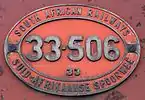
The two cabside number plates on Class 33-400 locomotives were not identical. Usually, all the locomotives in a Class would have either Afrikaans or English at the top of all their number plates. On the Class 33-400's number plates, the inscription was in Afrikaans at the top on the right hand or driver’s side, and in English at the top on the left hand or driver's assistant's side.
In South Africa, most of the Class 33-400 locomotives survived in mainline and branch line service well into the 21st century, for example on the lines from De Aar to Upington, from Worcester to Voorbaai and on suburban service out of East London. From 2009, some were also employed out of Cape Town on the Overberg line across Sir Lowry's Pass to Caledon and on the Bitterfontein line up the West Coast where they replaced several Classes 35-000 and 35-400 locomotives that were leased to private railway operators in several Southern African countries.
Some were employed for a while as heavy shunting engines to assemble or unload iron ore trains at the Sishen-Saldanha iron ore line's terminals until the arrival of the Class 43-000 in 2011 made more Classes 34-000, 34-400, 34-500 and 34-900 locomotives available for this task.[3]
Zambia
Between October 1978 and May 1993, Zambia Railways (ZR) hired locomotives to solve its chronic shortages in motive power, mainly from South Africa but at times also from Zaire, Zimbabwe, the TAZARA Railway and even the Zambian Copper Mines. In Zambia, the South African locomotives were mainly used on goods trains between Livingstone and Kitwe, sometimes in tandem with a ZR locomotive and occasionally also on passenger trains.[5]

Locomotives were selected from a pool of engines which was allocated by the Railways for hire to Zambia. The South African fleet in Zambia was never constant since locomotives were continually exchanged as they became due back in South Africa for their three-monthly services. The locomotives were initially selected from the Classes 33-400, 35-000 and 35-200, but by December 1989 some Class 33-000 locomotives also began to serve one or more tours of duty in Zambia.[5]
The pool of Class 33-400 locomotives allocated by the Railways for hire to ZR from time to time included the locomotives as shown in the "Leased to" column in the table. The last Class 33-400 locomotive to serve in Zambia was no. 33-491 which was returned in April 1992. By the end of May 1993, no more South African locomotives were working in Zambia.[5]
South America
In 1997, twenty Class 33-400 locomotives were sold to Ferrovia Centro-Atlântica (FCA). They were since resold in 1999 to América Latina Logística (ALL) in Brazil where they retained their FCA engine numbers.[3]
In 2003, three of these locomotives, ex SAR numbers 33-410 (ALL 2663), 33-452 (2668) and 33-481 (2679), were resold to the Ferroviaria Oriental (FOB) in Bolivia. Of these, two were resold again to Sociedad Química y Minera (SQM) in Chile.[3][6]
Of these twenty locomotives in South America, ten still survived by July 2010. These include the three units sold to FOB and subsequently resold to EFO and SQM, five locomotives reported as non-operating and two which were returned to Rede Ferroviária Federal, Sociedade Anônima (RFFSA), the state-owned federal railroad network of Brazil.
Sudan Railways
Ten Class 33-400 locomotives were sold to the Sudan Railways.[3]
Democratic Republic of the Congo
In 2015, some Class 33-000 and Class 33-400 locomotives were sold to the Congolese Company for Transportation and Ports (SCTP, formerly Onatra) in the Democratic Republic of the Congo. These locomotives were refurbished in South Africa prior to being delivered to their new owners.
Industrial service
Six Class 33-400 locomotives were sold to Iscor (now Kumba Iron Ore) for use at its Vanderbijlpark steel works and at Kumba’s Grootgeluk Colliery at Ellisras.[3]
Preservation
One loco Class 33-400 no. 33-487 has been marked down on TRANSnet Heritage Foundation as a historic locomotive set to be preserved in the near future it currently resides at East London - Cambridge.[7]
Liveries
The class 33-400 were all delivered in the Gulf Red livery with yellow side-stripes on the long hood, a yellow V on each end, signal red buffer beams and unpainted steel cowcatchers. Most of them wore this livery throughout their SAR service life. In the Spoornet era at least one was painted in Spoornet orange livery with yellow and blue chevron buffer beams and in the Transnet Freight Rail era at least one was painted in its red, green and yellow livery.[8]
Works numbers
The Class 33-400 builder’s works numbers and eventual disposition are listed in the table.[3]
SAR no. |
Works no. |
Leased to |
Post-SAR owner |
Post-SAR no. |
Rebuilt, or Resold to: |
Rebuilt or Resold no. |
|---|---|---|---|---|---|---|
| 33-401 | 36530 | FCA & ALL | 2670 | |||
| 33-402 | 36531 | TransNamib | 402 | |||
| 33-403 | 36532 | Zambia | Sudan | |||
| 33-404 | 36533 | Sudan | ||||
| 33-405 | 36534 | TransNamib | 405 | |||
| 33-406 | 36535 | Zambia | Sudan | |||
| 33-407 | 36536 | Zambia | TransNamib | 407 | TransNamib | 508 |
| 33-408 | 36537 | Sudan | ||||
| 33-409 | 36538 | Sudan | ||||
| 33-410 | 36539 | FCA & ALL | 2663 | FOB (EFO) | 2009 | |
| 33-411 | 36540 | Sudan | ||||
| 33-412 | 36541 | TransNamib | 412 | |||
| 33-413 | 36542 | TransNamib | 413 | |||
| 33-414 | 36543 | TransNamib | 414 | TransNamib | 503 | |
| 33-415 | 36544 | Sudan | ||||
| 33-416 | 36545 | TransNamib | 416 | |||
| 33-417 | 36546 | TransNamib | 417 | |||
| 33-418 | 36547 | |||||
| 33-419 | 36548 | TransNamib | 419 | TransNamib | 507 | |
| 33-420 | 36549 | |||||
| 33-421 | 36550 | Zambia | FCA & ALL | 2661 | ||
| 33-422 | 36551 | Zambia | TransNamib | 422 | TransNamib | 505 |
| 33-423 | 36552 | Zambia | FCA & ALL | 2680 | ||
| 33-424 | 36553 | Sudan | ||||
| 33-425 | 36554 | Zambia | TransNamib | 425 | TransNamib | 509 |
| 33-426 | 36555 | |||||
| 33-427 | 36556 | Zambia | TransNamib | 427 | ||
| 33-428 | 36557 | FCA & ALL | 2666 | |||
| 33-429 | 36558 | Zambia | FCA & ALL | 2665 | ||
| 33-430 | 36559 | TransNamib | 430 | |||
| 33-431 | 36560 | TransNamib | 431 | |||
| 33-432 | 36561 | TransNamib | 432 | |||
| 33-433 | 36562 | FCA & ALL | 2672 | |||
| 33-434 | 36563 | TransNamib | 434 | TransNamib | 502 | |
| 33-435 | 36564 | TransNamib | 435 | |||
| 33-436 | 36565 | Kumba E | 7 | |||
| 33-437 | 36566 | Zambia | TransNamib | 437 | ||
| 33-438 | 36567 | FCA & ALL | 2669 | |||
| 33-439 | 36568 | Zambia | FCA & ALL | 2677 | ||
| 33-440 | 36569 | Zambia | Sudan | |||
| 33-441 | 36570 | Zambia | TransNamib | 441 | ||
| 33-442 | 36571 | Zambia | TransNamib | 442 | ||
| 33-443 | 36572 | Zambia | TransNamib | 443 | ||
| 33-444 | 36573 | TransNamib | 444 | |||
| 33-445 | 36574 | Zambia | TransNamib | 445 | ||
| 33-446 | 36575 | Zambia | TransNamib | 446 | ||
| 33-447 | 36576 | TransNamib | 447 | |||
| 33-448 | 36577 | FCA & ALL | 2664 | |||
| 33-449 | 36578 | Zambia | FCA & ALL | 2678 | ||
| 33-450 | 36579 | Sudan | ||||
| 33-451 | 36580 | FCA & ALL | 2671 | |||
| 33-452 | 36581 | FCA & ALL | 2668 | FOB & SQM | 4 or 5 | |
| 33-453 | 36582 | TransNamib | 453 | TransNamib | 501 | |
| 33-454 | 36583 | Kumba V | 67 | |||
| 33-455 | 36584 | Zambia | TransNamib | 455 | TransNamib | 506 |
| 33-456 | 36585 | Kumba E | 4 | |||
| 33-457 | 36586 | Zambia | TransNamib | 457 | ||
| 33-458 | 36587 | FCA & ALL | 2675 | |||
| 33-459 | 36588 | TransNamib | 459 | |||
| 33-460 | 36589 | Zambia | TransNamib | 460 | ||
| 33-461 | 36590 | Kumba V | 68 | |||
| 33-462 | 36591 | Kumba V | 69 | |||
| 33-463 | 36592 | Zambia | TransNamib | 463 | ||
| 33-464 | 36593 | TransNamib | 464 | |||
| 33-465 | 36594 | TransNamib | 465 | |||
| 33-466 | 36595 | FCA & ALL | 2676 | |||
| 33-467 | 36596 | |||||
| 33-468 | 36597 | TransNamib | 468 | |||
| 33-469 | 36598 | FCA & ALL | 2674 | |||
| 33-470 | 36599 | TransNamib | 470 | |||
| 33-471 | 36600 | Kumba E | 5 | |||
| 33-472 | 36601 | TransNamib | 472 | |||
| 33-473 | 36602 | TransNamib | 473 | |||
| 33-474 | 36603 | TransNamib | 474 | |||
| 33-475 | 36604 | TransNamib | 475 | TransNamib | 504 | |
| 33-476 | 36605 | TransNamib | 476 | |||
| 33-477 | 36606 | FCA & ALL | 2673 | |||
| 33-478 | 36607 | TransNamib | 478 | TransNamib | 511 | |
| 33-479 | 36608 | TransNamib | 479 | |||
| 33-480 | 36609 | TransNamib | 480 | |||
| 33-481 | 36610 | FCA & ALL | 2679 | FOB & SQM | 4 or 5 | |
| 33-482 | 36611 | FCA & ALL | 2662 | |||
| 33-483 | 36612 | TransNamib | 483 | |||
| 33-484 | 36613 | TransNamib | 484 | TransNamib | 510 | |
| 33-485 | 36614 | FCA & ALL | 2667 | |||
| 33-486 | 36615 | Zambia | TransNamib | 486 | ||
| 33-487 | 36616 | Zambia | ||||
| 33-488 | 36617 | Zambia | ||||
| 33-489 | 36618 | Zambia | TransNamib | 489 | ||
| 33-490 | 36619 | Zambia | ||||
| 33-491 | 36620 | Zambia | ||||
| 33-492 | 36621 | Zambia | ||||
| 33-493 | 36622 | Zambia | TransNamib | 493 | ||
| 33-494 | 36623 | Zambia | TransNamib | 494 | ||
| 33-495 | 36624 | Zambia | ||||
| 33-496 | 36625 | Zambia | ||||
| 33-497 | 36626 | Zambia | ||||
| 33-498 | 36627 | Zambia | ||||
| 33-499 | 36628 | Zambia | ||||
| 33-500 | 36629 | Zambia | ||||
| 33-501 | 36630 | Zambia | ||||
| 33-502 | 36631 | Zambia | ||||
| 33-503 | 36632 | Zambia | ||||
| 33-504 | 36633 | Zambia | ||||
| 33-505 | 36634 | Zambia | ||||
| 33-506 | 36635 | Zambia | ||||
| 33-507 | 36636 | Zambia | ||||
| 33-508 | 36637 | Zambia | ||||
| 33-509 | 36638 | Zambia | ||||
| 33-510 | 36639 | Zambia | TransNamib | |||
| 33-511 | 36640 | Zambia | ||||
| 33-512 | 36641 | Zambia | ||||
| 33-513 | 36642 | Zambia | ||||
| 33-514 | 36643 | Zambia | ||||
| 33-515 | 36644 | Zambia | ||||
Illustration
The main picture and the following serve to illustrate the distinguishing features of the Class and some of the liveries that they served in.
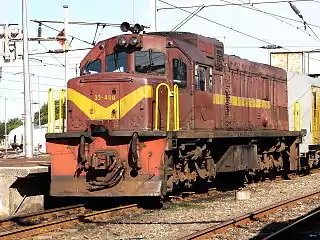 No. 33-488 in SAR Gulf Red and whiskers livery at East London, 24 April 2013
No. 33-488 in SAR Gulf Red and whiskers livery at East London, 24 April 2013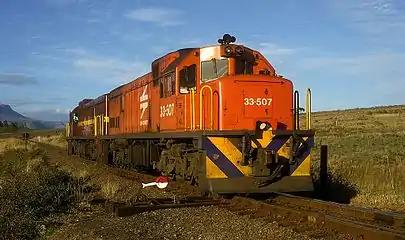 No. 33-507, the only known locomotive of the Class in Spoornet orange livery, at Swellendam, 20 August 2001
No. 33-507, the only known locomotive of the Class in Spoornet orange livery, at Swellendam, 20 August 2001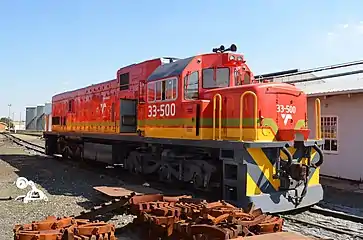 No. 33-500 in Transnet Freight Rail livery at Germiston diesel depot, Gauteng, 1 May 2013
No. 33-500 in Transnet Freight Rail livery at Germiston diesel depot, Gauteng, 1 May 2013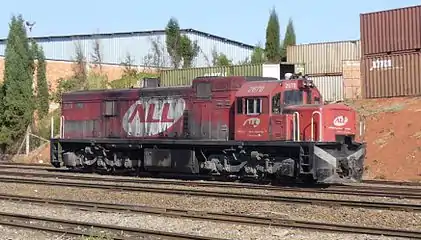
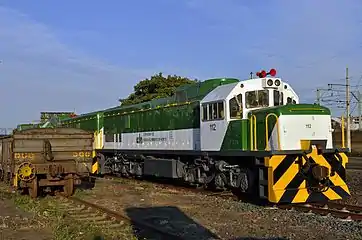 Class 33-400 no. 112, sold to the Corredor de Desenvolvimento do Norte of Nacala, Mozambique, 1 June 2013
Class 33-400 no. 112, sold to the Corredor de Desenvolvimento do Norte of Nacala, Mozambique, 1 June 2013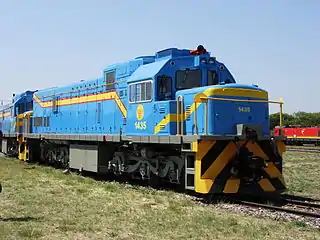 Class 33-400 no. 1435, sold to the Congolese SCTP, at Koedoespoort, 29 September 2015
Class 33-400 no. 1435, sold to the Congolese SCTP, at Koedoespoort, 29 September 2015
References
- 1 2 South African Railways Index and Diagrams Electric and Diesel Locomotives, 610mm and 1065mm Gauges, Ref LXD 14/1/100/20, 28 January 1975, as amended
- ↑ Paxton, Leith; Bourne, David (1985). Locomotives of the South African Railways (1st ed.). Cape Town: Struik. pp. 139–140. ISBN 0869772112.
- 1 2 3 4 5 6 7 Middleton, John N. (2002). Railways of Southern Africa Locomotive Guide - 2002 (as amended by Combined Amendment List 4, January 2009) (2nd, Dec 2002 ed.). Herts, England: Beyer-Garratt Publications. pp. 38–39, 45, 47, 66.
- ↑ Pivnic, Les. "System 7, Western Transvaal, based in Johannesburg, Part 25: Krugersdorp-Zeerust-Mafeking (Home Signal), Part 2". Soul of A Railway. Caption 50. Retrieved 6 May 2017.
- 1 2 3 Bagshawe, P.F. Spoornet Diesels Leased to ZR 1978-1993.
- ↑ "33 Class in Chile". Friends of the Rail. Retrieved 29 May 2017.
- ↑ "2017016 Locomotive status - January 2017". Google Docs. Sandstone Heritage Trust. Retrieved 8 March 2019.
- ↑ Pivnic, Les. "System 7, Western Transvaal, based in Johannesburg, Part 6. Germiston, the Steam and Diesel Running Sheds". Soul of A Railway. Caption 33. Retrieved 7 April 2017.